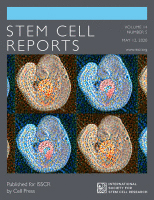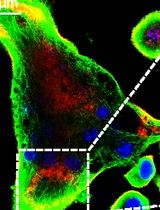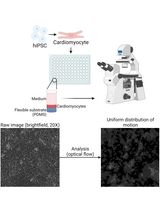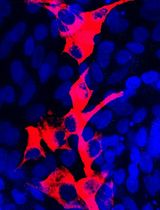- EN - English
- CN - 中文
Rapid and Simplified Induction of Neural Stem/Progenitor Cells (NSCs/NPCs) and Neurons from Human Induced Pluripotent Stem Cells (hiPSCs)
从人诱导的多能干细胞(hiPSCs)快速简便地诱导神经干/祖细胞(NSCs/NPCs)和神经元
发布: 2021年02月05日第11卷第3期 DOI: 10.21769/BioProtoc.3914 浏览次数: 6691
评审: Giusy TornilloVishal NehruLu Song
Abstract
Human induced pluripotent stem cells (iPSCs) and their progeny displaying tissue-specific characteristics have paved the way for regenerative medicine and research in various fields such as the elucidation of the pathological mechanism of diseases and the discovery of drug candidates. iPSC-derived neurons are particularly valuable as it is difficult to analyze neural cells obtained from the central nervous system in humans. For neuronal induction with iPSCs, one of the commonly used approaches is the isolation and expansion of neural rosettes, following the formation of embryonic bodies (EBs). However, this process is laborious, inefficient, and requires further purification of the cells. To overcome these limitations, we have developed an efficient neural induction method that allows for the generation of neural stem/progenitor cells (NSCs/NPCs) from iPSCs within 7 days and of functional mature neurons. Our method yields a PAX6-positive homogeneous cell population, a cortical NSCs/NPCs, and the resultant NSCs/NPCs can be cryopreserved, expanded, and differentiated into functional mature neurons. Moreover, our protocol will be less expensive than other methods since the protocol requires fewer neural supplements during neural induction. This article also presents the FM1-43 imaging assay, which is useful for the presynaptic assessment of the iPSCs-derived human neurons. This protocol provides a quick and simplified way to generate NSCs/NPCs and neurons, enabling researchers to establish in vitro cellular models to study brain disease pathology.
Keywords: Human Induced Pluripotent Stem Cell (人诱导多能干细胞)Background
Human iPSCs were first established in 2007 through the reprogramming of dermal fibroblasts using four transcription factors (Oct4, Sox2, Klf4, and c-Myc) and exhibited similar characteristics of embryonic stem cells (ESCs), including their pluripotency and self-renewal (Takahashi et al., 2007; Yu et al., 2007). Since iPSCs overcome the limitation of the ethical problems and the allogenic immune rejection, which ESCs also have, they are highly expected to be applied to regenerative medicine. Importantly, researchers can establish disease-specific iPSCs from patients’ somatic cells, including skin fibroblasts, keratinocytes, cord blood-derived endothelial cells, peripheral blood mononuclear cells, and surprisingly tumor cells (Raab et al., 2014; Marin Navarro et al., 2018; Saha et al., 2018).
Driving disease iPSCs into tissue-specific cells enables us to obtain target cells, study the diseases' etiology and pathogenesis, and evaluate the efficacy or toxicity of drugs using the patients’ cells (Inoue et al., 2014). Before establishing iPSC technology, it was almost impossible to analyze the affected neural cells in the central nervous system from patients with neurodegenerative diseases as the biopsy is not always available for the human brain. Therefore, the iPSC-based disease models are expected to be a powerful approach in elucidating the pathogenesis of neurodegenerative diseases and in drug discovery because they mimic pathological conditions that have not been easily reproduced in animal models and cultured cell lines (Dimos et al., 2008; Soga et al., 2015; Matsushita et al., 2019; Kajihara et al., 2020; Kido et al., 2020). So far, neuronal cells derived from disease-specific iPSCs in vitro have been used to study the pathology of neurodegenerative diseases including Alzheimer’s disease, Parkinson's disease, and amyotrophic lateral sclerosis (ALS), and they accurately recapitulated the pathological changes that occur in the patients’ brain (Dimos et al., 2008; Inoue et al., 2014).
The generation of disease-derived iPSCs was first established in 2008 by Dimos et al. using fibroblasts obtained from patients with familial ALS (Dimos et al., 2008). They induced ALS-specific iPSCs into motor neurons via EB formation. For many years, the major methods for neural induction from human ESCs and iPSCs have been either co-culture with a stromal cell line (Kawasaki et al., 2000; Lee et al., 2007) or the formation of EBs (Nemati et al., 2011; Falk et al., 2012; Shi et al., 2012), which involve the time-consuming steps, resulting in low-efficiency derivation of NSCs/NPCs. In the EB-based protocol, iPSCs are plated on a low adherence plate to form EBs, where EBs gradually aggregate over 5-7 days. These EBs are then transferred to a plate that supports cell adhesion, allowing the EBs to adhere to the bottom of the plate and spread in a neural rosette shape. From these rosettes, NSCs can be generated and passaged to form relatively stable NPCs. NPCs can then be plated in a neuron induction medium to be differentiated into mature neurons. Each of these methods (i.e., co-culture with a stromal cell line, or the formation of EBs) has contributed significantly to the field's advancement. However, some of these methods are not easily reproducible due to the variability of the iPSC lines or are not scalable to the extent needed for disease modeling, high-throughput screening, or cell therapy. Therefore, a simplified NSCs/NPCs generation protocol needs to be developed to the demands of research in brain development and neurological disorders.
Recent studies have shown that human iPSCs can be induced even into a monolayer neural culture in which iPSCs are plated on a defined matrix and exposed to growth factors (Chambers et al., 2009; Li et al., 2011; Yan et al., 2013). The monolayer-based protocols differ primarily in that iPSC colonies are maintained as a monolayer during neural induction and are differentiated directly into NSCs/NPCs without aggregation. Moreover, studies also demonstrated that dual SMAD inhibition enhances the efficiency of neural induction from iPSCs, in which small-compound inhibitors, SB431542 and dorsomorphin, block TGFβ/activin/nodal and BMP signaling, respectively (Chambers et al., 2009; Morizane et al., 2011). It is well-known that TGFβ/activin/nodal signaling activates SMAD2/3 and promotes mesoderm induction (Dunn et al., 2004; Nishikawa et al., 2007; Era et al., 2008), while BMP signaling activates SMAD1/5/8 and induces mesendoderm differentiation (Tada et al., 2005; Wang and Chen, 2016). Thus, inhibiting these two SMAD signals results in promoting the ectoderm differentiation, including neural cells.
Herein, we describe a methodology for rapid and reproducible induction to the NSCs/NPCs from iPSCs within a week in a monolayer culture system without the process of EB formation. Our method yields a PAX6-positive homogeneous cell population, a cortical NSCs/NPCs (Matsushita et al., 2019; Kajihara et al., 2020). Moreover, differentiated mature neurons via the NSCs/NPCs by our protocol are capable of neurotransmission revealed by FM1-43 imaging assay.
Materials and Reagents
100-mm dish (Falcon, catalog number: 353003 )
Glass pasteur pipette (Fisherbland, catalog number: 13-678-20C )
200 μl pipette tip (Greiner, catalog number: 739291 )
6-well plate (Falcon, catalog number: 353046 )
15-ml conical tube (CORNING, catalog number: 430791 )
10 ml pipette (VIOLAMO, catalog number: 2-5237-04 )
Glass bottom dish (Matsunami Glass Ind., catalog number: D1113OH )
Cryovial (Nunc, catalog number: 340711 )
Geltrex hESC-Qualified, Ready-To-Use, Reduced Growth Factor Basement Membrane Matrix (Thermo Fisher Scientific, Gibco, catalog number: A1569601 )
Collagenase Type IV (1 mg/ml) (STEMCELL Technologies, catalog number: 0 7909 )
PBS without CaCl2 and MgCl2 (Thermo Fisher Scientific, Gibco, catalog number: 14190 )
Accutase Cell Dissociation Reagent (Funakoshi, catalog number: AT104-500 )
Trypan Blue Solution (Thermo Fisher Scientific, Gibco, catalog number: 15250061 )
ROCK Inhibitor Y27632 (PeproTech, BioGems, catalog number: 1293823 )
NaCl (WAKO, catalog number: 198-01675 )
KCl (WAKO, catalog number: 163-03545 )
CaCl2·2H2O (WAKO, catalog number: 033-25035 )
MgCl2·6H2O (WAKO, catalog number: 135-00165 )
NaHCO3 (WAKO, catalog number: 191-01305 )
Glucose (WAKO, catalog number: 049-31165 )
Polyethylenimine (WAKO, catalog number: 167-17811 )
DMEM/F12 (SIGMA, catalog number: D8900-1L )
NON-ESSENTIAL AMINO ACID (×100) (SIGMA, catalog number: M7145 )
200 mM L-GLUTAMINE (Thermo Fisher Scientific, Gibco, catalog number: 25030-081 )
KnockOut Serum Replacement (Thermo Fisher Scientific, Gibco, catalog number: 10828-028 )
2-Mercaptoethanol (Wako, catalog number: 131-14572 )
bFGF (basic fibroblast growth factor) (Wako, catalog number: 060-04543 )
BSA (bovine serum albumin) (Wako, catalog number: 012-23381 )
PSC Neural Induction Medium (consists of Neurobasal Medium and Neural Induction Supplement, 50×) (Thermo Fisher Scientific, Gibco, catalog number: A1647801 )
Advanced DMEM/F12 (Thermo Fisher Scientific, Gibco, catalog number: 12634 )
DMSO (dimethyl sulfoxide) (Sigma-Aldrich, catalog number: D2650 )
B-27 Supplement (50×) (Thermo Fisher Scientific, Gibco, catalog number: 17504044 )
Hoechst 33258 (Thermo Fisher Scientific, Invitrogen, catalog number: H3569 )
Anti-SOX1 (Cell Signaling Technology, catalog number: 4194S )
Anti-NESTIN (R&D systems, catalog number: MAB1259 )
Anti-PAX6 (Covance, catalog number: PRB-278P )
Anti-Polysialic Acid (PSA)-NCAM (MilliporeSigma, catalog number: MAB5324 )
Anti-Tuj1 (MilliporeSigma, catalog number: MAB1637 )
Anti-MAP2 (MilliporeSigma, catalog number: Ab5622 )
Alexa 488-conjugated donkey anti-rabbit IgG (Thermo Fisher Scientific, Invitrogen, catalog number: A21206 )
Alexa 488-conjugated goat anti-mouse IgM (Thermo Fisher Scientific, Invitrogen, catalog number: A21042 )
Alexa 594-conjugated donkey anti-rabbit IgG (Thermo Fisher Scientific, Invitrogen, catalog number: A21207 )
Alexa 594-conjugated goat anti-mouse IgG (Thermo Fisher Scientific, Invitrogen, catalog number: A11005 )
FM1-43 (Thermo Fisher Scientific, Invitrogen, catalog number: T3163 )
4% Paraformaldehyde Phosphate Buffer Solution (WAKO, catalog number: 161-20141 )
Triton X-100 (Nacalai, catalog number: 35501-15 )
Double Neubauer Counting Chamber Set (NIPPON Genetics, catalog number: 15170-089 )
iPSC medium (see Recipes)
Neural Induction Medium (see Recipes)
Neural Expansion Medium (see Recipes)
NSC freezing medium (see Recipes)
Polyethylenimine (PEI) solution (see Recipes)
Neuronal Medium (see Recipes)
Neuronal Maturation Medium (see Recipes)
Artificial Cerebrospinal Fluid (see Recipes)
Equipment
Biological safety cabinet (Dalton, model: DFC79 )
Pipettes (Fisher, catalog number: 4680100 )
Water bath (AS ONE, model: TR-3α )
Inverted microscope (Olympus, model: CKX53 )
Incubator (Thermo Fisher, catalog number: 51030287 )
Centrifuge (Kubota, model: 6200 )
Milli-Q (MILLIPORE, model: C79625 )
Fluorescence microscope (Leica, model: DMi8 )
Software
Excel 2019 (Microsoft, https://www.microsoft.com/en-ca/microsoft-365/excel)
Leica Application Suite X (LAS X) (Leica, https://www.leica-microsystems.com/products/microscope-software/p/leica-las-x-ls/)
Procedure
文章信息
版权信息
© 2021 The Authors; exclusive licensee Bio-protocol LLC.
如何引用
Kajihara, R., Numakawa, T. and Era, T. (2021). Rapid and Simplified Induction of Neural Stem/Progenitor Cells (NSCs/NPCs) and Neurons from Human Induced Pluripotent Stem Cells (hiPSCs). Bio-protocol 11(3): e3914. DOI: 10.21769/BioProtoc.3914.
分类
干细胞 > 多能干细胞 > 细胞诱导
细胞生物学 > 细胞分离和培养 > 细胞分化
您对这篇实验方法有问题吗?
在此处发布您的问题,我们将邀请本文作者来回答。同时,我们会将您的问题发布到Bio-protocol Exchange,以便寻求社区成员的帮助。
提问指南
+ 问题描述
写下详细的问题描述,包括所有有助于他人回答您问题的信息(例如实验过程、条件和相关图像等)。
Share
Bluesky
X
Copy link














